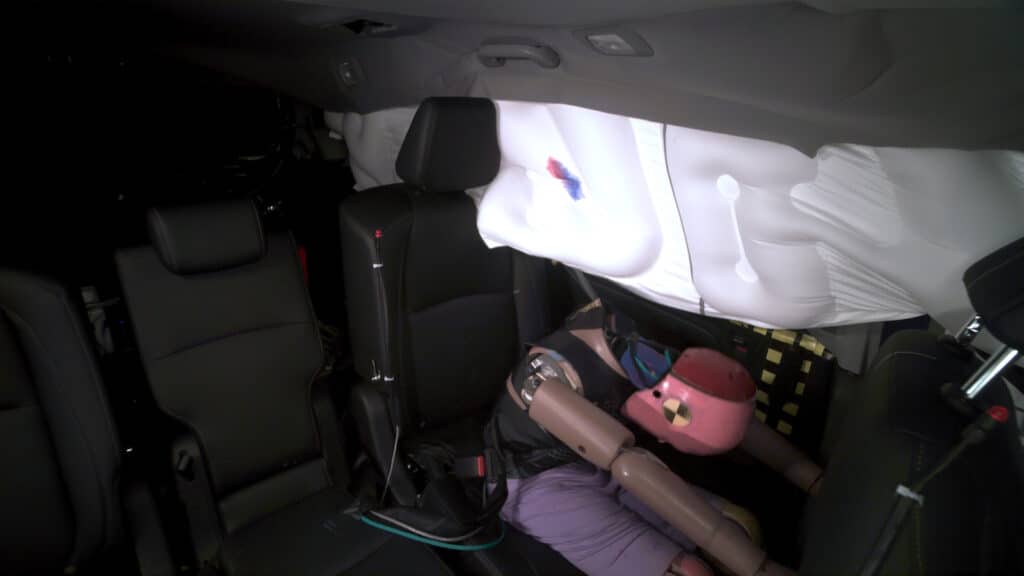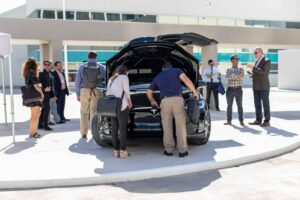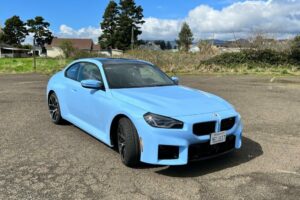
A new round of crash testing by the Insurance Institute for Highway Safety holds concerning news for those driving minivans. When put though the new moderate overlap front crash test, which now places more emphasis on back seat safety, none of the four minivans tested — the Chrysler Pacifica, Kia Carnival, Toyota Sienna, and Honda Odyssey — earned an acceptable or good rating.
The agency rates the Chrysler Pacifica, Kia Carnival and Toyota Sienna as marginal, while the Honda Odyssey is rated poor. Even worse, only the Sienna has a seat belt reminder for the second-row seats.
“Back seat safety is important for all vehicles, but it’s especially vital for those, like minivans, that customers are choosing specifically to transport their families,” said IIHS President David Harkey. “It’s disappointing that automakers haven’t acted faster to apply the best available technology to the second row in this vehicle class.”
What the tests show
The front seat of all four minivans offers good protection. But when it comes to the second row, each one suffers from a variety of problems, according to the IIHS.

“The restraint systems in all four vehicles leave the second-row occupant vulnerable to chest injuries, either because of excessive belt forces or poor belt positioning,” said Jessica Jermakian, IIHS vice president of vehicle research. “That’s concerning because those injuries can be life threatening.”
Only the Sienna is equipped with belt pretensioners and force limiters, which lessen the force of the belt. However, throughout the test, the shoulder belt migrated off the shoulder and toward the dummy’s neck, while the back dummy submarined beneath the lap belt.
The seat belt put too much pressure on the dummy’s chest in the Kia Carnival and Chrysler Pacifica, and concerningly, the Pacifica’s side curtain airbag did not inflate throughout the test. The chances of a head or neck damage increased in the Kia Carnival due to the stresses on the rear dummy’s neck being significantly higher than they were in the Chrysler Pacifica and Toyota Sienna. The forces on the head and neck were far greater in the Honda Odyssey, as the rear seat belt caused the dummy’s head to be too close to the front seatback, increasing the likelihood of head injuries.
A new, tougher test

After studies revealed the risk of a fatal injury is now higher for belted occupants in the second row than for those in the front, IIHS introduced an updated moderate overlap front test last year.
The front seat is now safer than the second row due to upgraded airbags and modern seat belts that are rarely offered in the back. Nevertheless, the back seat is still the safest option for kids because the front airbag can injure them.
Notably, the rating does not apply to kids who are properly buckled into child safety seats.
For the new test, a dummy the size of a 12-year-old kid or a petite woman is placed in the second row behind the driver that’s the size of a typical adult male, with IIHS researchers measure the injuries that are most frequently experienced by backseat passengers.
The second-row dummy should maintain its proper position during the collision, avoiding “submarining,” or moving forward behind the lap belt, which increases the risk of stomach injuries. Additionally, the head should keep a safe distance from the front seatback and the rest of the interior of the car, and the shoulder belt should stay on the shoulder, where it is most useful. The shoulder belt position during the crash is examined using a pressure sensor on the torso of the rear dummy.
- SEO Powered Content & PR Distribution. Get Amplified Today.
- PlatoData.Network Vertical Generative Ai. Empower Yourself. Access Here.
- PlatoAiStream. Web3 Intelligence. Knowledge Amplified. Access Here.
- PlatoESG. Carbon, CleanTech, Energy, Environment, Solar, Waste Management. Access Here.
- PlatoHealth. Biotech and Clinical Trials Intelligence. Access Here.
- Source: https://www.thedetroitbureau.com/2023/09/minivans-arent-as-safe-as-you-think-study-claims/
- :has
- :is
- :not
- :where
- 2023
- a
- acceptable
- According
- Additionally
- Adult
- agency
- All
- an
- and
- Apply
- ARE
- AS
- automakers
- available
- avoiding
- back
- BE
- because
- behind
- being
- BEST
- Bureau
- but
- by
- CAN
- car
- Carnival
- caused
- chances
- child
- choosing
- chrysler
- claims
- class
- Close
- collision
- comes
- concerning
- Crash
- curtain
- Customers
- damage
- David
- DID
- disappointing
- distance
- does
- driver
- driving
- due
- during
- each
- earned
- either
- emphasis
- equipped
- especially
- Even
- experienced
- families
- far
- faster
- For
- Force
- Forces
- Forward
- four
- frequently
- from
- front
- good
- greater
- head
- higher
- Highway
- highway safety
- holds
- However
- HTTPS
- important
- in
- increased
- Increases
- increasing
- indicate
- indicates
- Institute
- insurance
- interior
- into
- introduced
- IT
- ITS
- jpg
- Keep
- Kia
- Kid
- kids
- Last
- Last Year
- Leave
- Life
- like
- likelihood
- likely
- Low
- maintain
- max-width
- measure
- migrated
- moderate
- Modern
- more
- most
- moving
- much
- Nevertheless
- New
- news
- None
- now
- of
- off
- offered
- Offers
- on
- ONE
- only
- Option
- or
- Places
- plato
- Plato Data Intelligence
- PlatoData
- poor
- position
- positioning
- president
- pressure
- problems
- proper
- properly
- protection
- put
- rarely
- rated
- Rates
- rating
- research
- researchers
- REST
- Revealed
- Risk
- round
- ROW
- safe
- safer
- safest
- Safety
- Said
- Second
- should
- side
- significantly
- Size
- specifically
- stay
- Still
- studies
- Study
- Suffers
- Systems
- Technology
- test
- tested
- Testing
- tests
- than
- that
- The
- their
- Them
- they
- think
- this
- those
- though?
- throughout
- to
- too
- toward
- toyota
- transport
- typical
- updated
- upgraded
- using
- Values
- variety
- vehicle
- Vehicles
- vice
- Vice President
- vital
- Vulnerable
- were
- when
- which
- while
- WHO
- with
- woman
- worse
- year
- you
- zephyrnet












